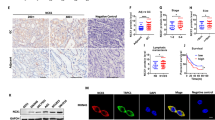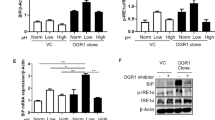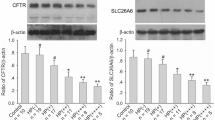Abstract
Clinical and laboratory studies have shown that bismuth subsalicylate (BSS) is helpful in the healing of gastric ulcers because of the bactericidal effects of bismuth (Bi3+) on H. pylori. Bismuth or BSS has also been reported to possess other nonbactericidal or “gastroprotective” effects in the stomach. It is known in other cell types that the effects of extracellular divalent or trivalent cations (e.g., Ca2+) can activate a plasma membrane-bound calcium-sensing receptor (CaSR). In a previous study, we found the existence of a CaSR which was activated by extracellular Ca2+ and found to increase intracellular Ca2+ [Ca2+]i, MAP-kinase activity, and gastric epithelial cell proliferation. In the present study, we were interested in determining whether the effects of the trivalent cation Bi3+ (in the form of BSS) on [Ca2+]i, MAP-kinase activity, and proliferation of gastric cells. We found that BSS dose dependently increased [Ca2+]i, p44/p42 and p38 MAP-kinase activites, and gastric mucous epithelial cell growth. The addition of BAPTA to chelate intracellular Ca2+ blocked BSS-induced p44/p42 MAP-kinase activities but not p38 MAP-kinase activity. The p44/p42 MAP-kinase inhibitor PD98059 and the p38 MAP-kinase inhibitor SB203580 dose dependently decreased gastric mucous cell growth over a 24 hr. All of the BSS-induced changes in [Ca2+]i, MAP-kinase activity, and gastric cell proliferation could be reproduced with the CaSR-agonist gadolinium (Gd3+). Our data suggest that BSS may possess additional novel effects by increasing gastric mucous epithelial cell growth through a Ca2+/MAP-kinase-dependent pathway.
Similar content being viewed by others
References
Marshall BJ, Forbes GM, Warren JR, Glaser ME, Cullen DJ, Collins BJ, McGechie DB, Rogers PA, Glancy RJ and Armstrong JA: The future of Helicobacter pylori eradication: a personal perspective. Aliment Pharmacol Ther 11 (Suppl 1):109-115, 1997
Gorbach SL: Bismuth therapy in gastrointestinal diseases. Gastroenterology 99:863-875, 1990
Mosby: Bismuth subsalicylate. Mosby's Drug Consult, 13th ed., New York, Elsevier, 2003, p 2503
Holroyde M, Yeakle C, Pepple S: Gastric cytoprotection by bismuth subsalicylate. Gastroenterology 86:1116, 1984
Sox TE, Olson CA: Binding and killing of bacteria by bismuth subsalicylate. Antimicrob Agents Chemother 33:2075-2082, 1989
Munoz DJ, Tasman-Jones C, Pybus J: Effect of Helicobacter pylori infection on colloidal bismuth subcitrate concentration in gastric mucus. Gut 33:592-596, 1992
Lee SP: The mode of action of colloidal bismuth subcitrate. Scand J Gastroenterol Suppl 185:1-6, 1991
Ottlecz A, Romero JJ, Hazell SL, Graham DY, Lichtenberger LM: Phospholipase activity of Helicobacter pylori and its inhibition by bismuth salts. Biochemical and biophysical studies. Dig Dis Sci 38:2071-2080, 1993
Konturek SJ, Dembinski A, Warzecha Z, Bielanski W, Brzozowski T, Drozdowicz D: Epidermal growth factor (EGF) in the gastroprotective and ulcer healing actions of colloidal bismuth subcitrate (De-Nol) in rats. Gut 29:894-902, 1988
Bagchi D, McGinn TR, Ye X, Balmoori J, Bagchi M, Stohs SJ, Kuszynski CA, Carryl OR, Mitra S: Mechanism of gastroprotection by bismuth subsalicylate against chemically induced oxidative stress in cultured human gastric mucosal cells. Dig Dis Sci 44:2419-2428, 1999
Bagchi D, Carryl OR, Tran MX, Bagchi M, Garg A, Milnes MM, Williams CB, Balmoori J, Bagchi DJ, Mitra S, Stohs SJ: Acute and chronic stress-induced oxidative gastrointestinal mucosal injury in rats and protection by bismuth subsalicylate. Mol Cell Biochem 196:109-116, 1999
Copeman M, Matuz J, Leonard AJ, Pearson JP, Dettmar PW, Allen A: The gastroduodenal mucus barrier and its role in protection against luminal pepsins: The effect of 16,16 dimethyl prostaglandin E2, carbopol-polyacrylate, sucralfate and bismuth subsalicylate. J Gastroenterol Hepatol 9:S55-S59, 1994
Tanaka S, Guth PH, Carryl OR, Kaunitz JD: Cytoprotective effect of bismuth subsalicylate in indomethacin-treated rats is associated with enhanced mucus bismuth concentration. Aliment Pharmacol Ther 11:605-612, 1997
Sidebotham RL, Batten JJ, Li K, Spencer J, Baron JH: Some effects of tripotassium dicitrato bismuthate on gastric secretion and the mucus barrier. Aliment Pharmacol Ther 4:535-546, 1990
Tanaka S, Guth PH, Paulsen G, Kaunitz JD: Gastroprotective effect of ranitidine bismuth citrate is associated with increased mucus bismuth concentration in rats. Gut 39:164-171, 1996
Suarez FL, Furne J, Stiehm J, Garten C, Levitt MD: Site of bismuth absorption from bismuth subsalicylate: implications for treatment of colonic conditions. Dig Dis Sci 45:1444-1446, 2000
Sandha GS, LeBlanc R, Van Zanten SJ, Sitland TD, Agocs L, Burford N, Best L, Mahoney D, Hoffman P, Leddin DJ: Chemical structure of bismuth compounds determines their gastric ulcer healing efficacy and anti-Helicobacter pylori activity. Dig Dis Sci 43:2727-2732, 1998
Dahlgren A, Glogard C, Gammelsaether M, Aasen AJ, Klaveness J, Berdal BP, Bergan T: Organobismuth compounds: activity against Helicobacter pylori. Scand J Gastroenterol 34:135-137, 1999
Hinsull SM: Effect of colloidal bismuth subcitrate on age related gastric lesions in the rat. Gut 32:355-360, 1991
Chiba N, Hunt RH, Thomson AB: Ranitidine bismuth citrate. Can J Gastroenterol 15:389-398, 2001
Wagstaff AJ, Benfield P, Monk JP: Colloidal bismuth subcitrate. A review of its pharmacodynamic and pharmacokinetic properties, and its therapeutic use in peptic ulcer disease. Drugs 36:132-157, 1988
Quarles LD, Hartle JE, 2nd, Middleton JP, Zhang J, Arthur JM and Raymond JR: Aluminum-induced DNA synthesis in osteoblasts: Mediation by a G-protein coupled cation sensing mechanism. J Cell Biochem 56:106-117, 1994
Brown EM, MacLeod RJ: Extracellular calcium sensing and extracellular calcium signaling. Physiol Rev 81:239-297, 2001
Brown EM, Gamba G, Riccardi D, Lombardi M, Butters R, Kifor O, Sun A, Hediger MA, Lytton J, Hebert SC: Cloning and characterization of an extracellular Ca2+-sensing receptor from bovine parathyroid. Nature 366:575-580, 1993
Buchan AM, Squires PE, Ring M, Meloche RM: Mechanism of action of the calcium-sensing receptor in human antral gastrin cells. Gastroenterology 120:1128-1139, 2001
Gama L, Baxendale-Cox LM, Breitwieser GE: Ca2+-sensing receptors in intestinal epithelium. Am J Physiol 273:C1168-C1175, 1997
Chattopadhyay N, Cheng I, Rogers K, Riccardi D, Hall A, Diaz R, Hebert SC, Soybel DI, Brown EM: Identification and localization of extracellular Ca2+-sensing receptor in rat intestine. Am J Physiol 274:G122-G130, 1998
Chakrabarty S, Radjendirane V, Appelman H, Varani J: Extracellular calcium and calcium sensing receptor function in human colon carcinomas: promotion of E-cadherin expression and suppression of beta-catenin/TCF activation. Cancer Res 63:67-71, 2003
Kallay E, Bajna E, Wrba F, Kriwanek S, Peterlik M, Cross HS: Dietary calcium and growth modulation of human colon cancer cells: role of the extracellular calcium-sensing receptor. Cancer Detect Prev 24:127-136, 2000
Kallay E, Kifor O, Chattopadhyay N, Brown EM, Bischof MG, Peterlik M, Cross HS: Calcium-dependent c-myc proto-oncogene expression and proliferation of Caco-2 cells: a role for a luminal extracellular calcium-sensing receptor. Biochem Biophys Res Commun 232:80-83, 1997
Kato M, Doi R, Imamura M, Furutani M, Hosotani R, Shimada Y: Calcium-evoked insulin release from insulinoma cells is mediated via calcium-sensing receptor. Surgery 122:1203-1211, 1997
Bapty BW, Dai LJ, Ritchie G, Jirik F, Canaff L, Hendy GN, Quamme GA: Extracellular Mg2+-and Ca2+-sensing in mouse distal convoluted tubule cells. Kidney Int 53:583-592, 1998
Tu CL, Oda Y, Bikle DD: Effects of a calcium receptor activator on the cellular response to calcium in human kerationocytes. J Invest Dermatol 113:340-345, 1999
McNeil SE, Hobson SA, Nipper V, Rodland KD: Functional calcium-sensing receptors in rat fibroblasts are required for activation of SRC kinase and mitogen-activated protein kinase in response to extracellular calcium. J Biol Chem 273:1114-1120, 1998
Hobson SA, Wright J, Lee F, McNeil SE, Bilderback T, Rodland KD: Activation of the MAP kinase cascade by exogenous calcium-sensing receptor. Mol Cell Endocrinol 200:189-198, 2003
Handlogten ME, Shiraishi N, Awata H, Huang C, Miller RT: Extracellular Ca2+-sensing receptor is a promiscuous divalent cation sensor that responds to lead. Am J Physiol Renal Physiol 279:F1083-F1091, 2000
Kifor O, MacLeod RJ, Diaz R, Bai M, Yamaguchi T, Yao T, Kifor I, Brown EM: Regulation of MAP kinase by calcium-sensing receptor in bovine parathyroid and CaR-transfected HEK293 cells. Am J Physiol Renal Physiol 280:F291-F302, 2001
Yamaguchi T, Chattopadhyay N, Kifor O, Sanders JL, Brown EM: Activation of p42/44 and p38 mitogen-activated protein kinases by extracellular calcium-sensing receptor agonists induces mitogenic responses in the mouse osteoblastic MC3T3-E1 cell line. Biochem Biophys Res Commun 279:363-368, 2000
Johnson GL, Lapadat R: Mitogen-activated protein kinase pathways mediated by ERK, JNK, and p38 protein kinases. Science 298:1911-1912, 2002
Elzi DJ, Bjornsen AJ, MacKenzie T, Wyman TH, Silliman CC: Ionomycin causes activation of p38 and p42/44 mitogen-activated protein kinases in human neutrophils. Am J Physiol Cell Physiol 281:C350-C360, 2001
Rutten MJ, Bacon KD, Marlink KL, Stoney M, Meichsner CL, Lee FP, Hobson SA, Rodland KD, Sheppard BC, Trunkey DD, Deveney KE, Deveney CW: Identification of a functional Ca2+-sensing receptor in normal human gastric mucous epithelial cells. Am J Physiol 277:G662-G670, 1999
Rutten MJ, Campbell DR, Luttropp CA, Fowler WM, Hawkey MA, Boland CR, Krauss ER, Sheppard BC, Crass RA, Deveney KE, Deveney CW: A method for the isolation of human gastric mucous epithelial cells for primary cell culture; A comparison of biopsy vs. surgical tissue. Methods Cell Sci 18:269-281, 1996
Lin K, Sadee W, Quillan JM: Rapid measurements of intracellular calcium using a fluorescence plate reader. Biotechniques 26:318-326, 1999
Thomas D, Tovey SC, Collins TJ, Bootman MD, Berridge MJ, Lipp P: A comparison of fluorescent Ca2+ indicator properties and their use in measuring elementary and global Ca2+ signals. Cell Calcium 28:213-223, 2000
Hellman P, Hellman B, Juhlin C, Juppner H, Rastad J, Ridefelt P, Akerstrom G: Regulation of proliferation in JEG-3 cells by a 500-kDa Ca2+ sensor and parathyroid hormone-related protein. Arch Biochem Biophys 307:379-385, 1993
Chattopadhyay N, Ye CP, Yamaguchi T, Kerner R, Vassilev PM, Brown EM: Extracellular calcium-sensing receptor induces cellular proliferation and activation of a nonselective cation channel in U373 human astrocytoma cells. Brain Res 851:116-124, 1999
Hobson SA, McNeil SE, Lee F, Rodland KD: Signal transduction mechanisms linking increased extracellular calcium to proliferation in ovarian surface epithelial cells. Exp Cell Res 258:1-11, 2000
Tu CL, Chang W, Bikle DD: The extracellular calcium-sensing receptor is required for calciuminduced differentiation in human keratinocytes. J Biol Chem 276:41079-41085, 2001
Racz GZ, Kittel A, Riccardi D, Case RM, Elliott AC, Varga G: Extracellular calcium sensing receptor in human pancreatic cells. Gut 51:705-711, 2002
Yamaguchi T, Yamauchi M, Sugimoto T, Chauhan D, Anderson KC, Brown EM, Chihara K: The extracellular calcium Ca2+ o-sensing receptor is expressed in myeloma cells and modulates cell proliferation. Biochem Biophys Res Commun 299:532-538, 2002
Mailland M, Waelchli R, Ruat M, Boddeke HG, Seuwen K: Stimulation of cell proliferation by calcium and a calcimimetic compound. Endocrinology 138:3601-3605, 1997
Chattopadhyay N, Ye CP, Yamaguchi T, Kifor O, Vassilev PM, Nishimura R, Brown EM: Extracellular calcium-sensing receptor in rat oligodendrocytes: expression and potential role in regulation of cellular proliferation and an outward K+ channel. Glia 24:449-458, 1998
Cheng I, Klingensmith ME, Chattopadhyay N, Kifor O, Butters RR, Soybel DI, Brown EM: Identification and localization of the extracellular calcium-sensing receptor in human breast. J Clin Endocrinol Metab 83:703-707, 1998
McNeil L, Hobson S, Nipper V, Rodland KD: Functional calcium-sensing receptor expression in ovarian surface epithelial cells. Am J Obstet Gynecol 178:305-313, 1998
Yamaguchi T, Chattopadhyay N, Kifor O, Butters RR Jr, Sugimoto T, Brown EM: Mouse osteoblastic cell line (MC3T3-E1) expresses extracellular calcium (Ca2+ o)-sensing receptor and its agonists stimulate chemotaxis and proliferation of MC3T3-E1 cells. J Bone Min Res 13:1530-1538, 1998
Quarles LD, Hartle JE 2nd, Siddhanti SR, Guo R, Hinson TK: A distinct cation-sensing mechanism in MC3T3-E1 osteoblasts functionally related to the calcium receptor. J Bone Min Res 12:393-402, 1997
Bai M, Quinn S, Trivedi S, Kifor O, Pearce SHS, Pollak MR, Krapcho K, Hebert SC, Brown EM: Expression and characterization of inactivating and activating mutations in the human Ca2+ o-sensing receptor. J Biol Chem 271:19537-19545, 1996
Motoyama HI, Friedman PA: Calcium-sensing receptor regulation of PTH-dependent calcium absorption by mouse cortical ascending limbs. Am J Physiol Renal Physiol 283:F399-F406, 2002
Galaris D, Evangelou A: The role of oxidative stress in mechanisms of metal-induced carcinogenesis. Crit Rev Oncol Hematol 42:93-103, 2002
Goldman R, Moshonov S, Chen X, Berchansky A, Furstenberger G, Zor U: Crosstalk between elevation of [Ca2+]i, reactive oxygen species generation and phospholipase A2 stimulation in a human keratinocyte cell line. Adv Exp Med Biol 433:41-45, 1997
Author information
Authors and Affiliations
Rights and permissions
About this article
Cite this article
Gilster, J., Bacon, K., Marlink, K. et al. Bismuth Subsalicylate Increases Intracellular Ca2+, MAP-Kinase Activity, and Cell Proliferation in Normal Human Gastric Mucous Epithelial Cells. Dig Dis Sci 49, 370–378 (2004). https://doi.org/10.1023/B:DDAS.0000020488.55854.99
Issue Date:
DOI: https://doi.org/10.1023/B:DDAS.0000020488.55854.99




